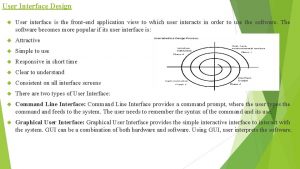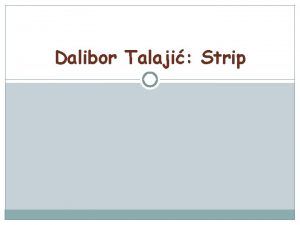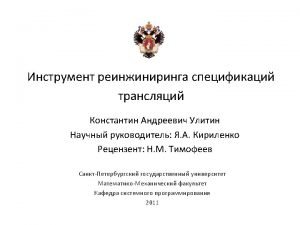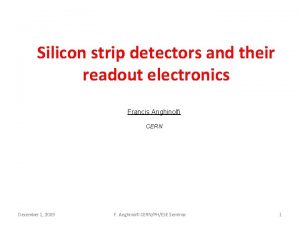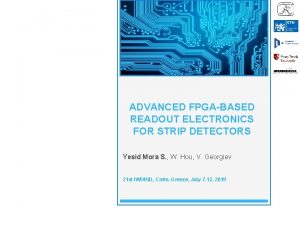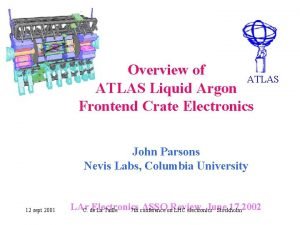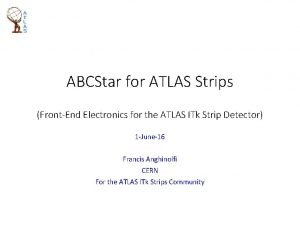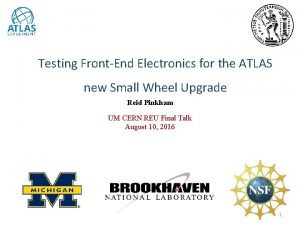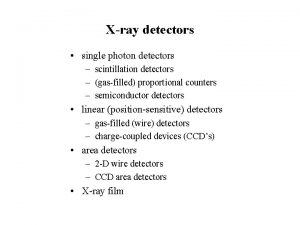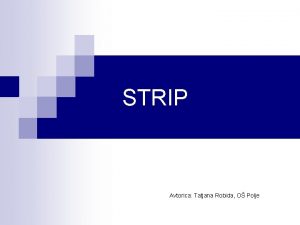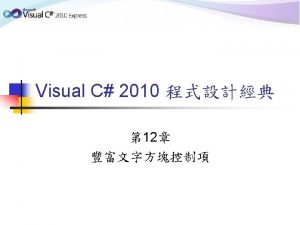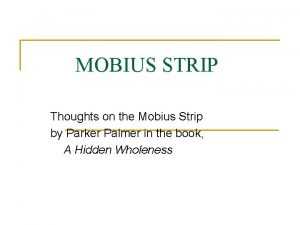Frontend Electronics for Strip Detectors an ATLAS perspective








![Fluence [1014 neq/cm 2] Radiation vs. Radius in Upgraded Tracker The usefulness of a Fluence [1014 neq/cm 2] Radiation vs. Radius in Upgraded Tracker The usefulness of a](https://slidetodoc.com/presentation_image_h/3044421b29db66dd4c233fe3b76f978b/image-9.jpg)





















- Slides: 30

Front-end Electronics for Strip Detectors (an ATLAS perspective on SLHC) 2 nd Trento Workshop on Advanced Silicon Radiation Detectors Trento, Italia 14 -Feb-2006 A. A. Grillo SCIPP – UCSC 14 Feb 06 1 Front-end Electronics for Strip Detectors nd 2 Trento Workshop on Advanced Si Rad Detectors A. A. Grillo SCIPP-UCSC 1

The ATLAS Strip Detector Readout The present ATLAS strip detector readout IC (named ABCD) is fabricated on the DMILL bi. CMOS technology. • The front-end amplifier, shaper and discriminator in bipolar. • The back-end pipeline, readout, command decoder, etc. in CMOS. The DMILL technology is no longer available and it would likely not be sufficiently rad-hard for the higher SLHC luminosity, at least not at the same radii. A new technology must be chosen. 14 Feb 06 2 Front-end Electronics for Strip Detectors nd 2 Trento Workshop on Advanced Si Rad Detectors A. A. Grillo SCIPP-UCSC 2

Deep Sub-micron CMOS a Possibility One obvious possibility is a complete IC in deep sub-micron CMOS. • Radiation hardness of 0. 25 mm CMOS has been demonstrated at levels sufficient for strip use at SLHC • Newer 0. 13 mm technologies are now being evaluated and are most likely at least as rad-hard if not more. A demonstration front-end circuit was designed and fabricated in 0. 25 mm CMOS a few years ago and was shown to meet present ATLAS noise and timing requirements. A proposal is now being discussed to build a CMOS replacement for the full ABCD chip to demonstrate feasibility and evaluate performance. 14 Feb 06 3 Front-end Electronics for Strip Detectors nd 2 Trento Workshop on Advanced Si Rad Detectors A. A. Grillo SCIPP-UCSC 3

Demonstration Front-end CMOS Circuit J. Kaplon et al. , 2004 IEEE Rome Oct 2004, use 0. 25 mm CMOS 14 Feb 06 4 Front-end Electronics for Strip Detectors nd 2 Trento Workshop on Advanced Si Rad Detectors A. A. Grillo SCIPP-UCSC 4

Past Experience A bi. CMOS technology was ideal for the existing ATLAS readout IC because: • We have shown for past experiments that the bipolar technology has advantages over CMOS in power and performance for frontend amplification when the capacitive loads are high and the shaping times short. • • • ZEUS-LPS SSC-SDC ATLAS-SCT Tek-Z IC LBIC IC ABCD, CAFE-M, CAFE-P ICs • CMOS is the preferred technology for memory and logic circuits of the back-end. • Bi. CMOS technology afforded both of these optimizations in one IC. Experience with commercial 0. 25 mm CMOS has shown the advantage of using a volume commercial rather than a niche technology. 14 Feb 06 5 Front-end Electronics for Strip Detectors nd 2 Trento Workshop on Advanced Si Rad Detectors A. A. Grillo SCIPP-UCSC 5

Technical Issues The ATLAS-ID upgrade will put even greater constraints on power. Can we meet power and shaping time requirements with deep submicron CMOS? • Achieving sufficient transconductance of the front-end transistor typically requires large bias currents. The timing of the SLHC is not yet fixed. If this dictates a faster shaping time, the transconductance vs. power will become a bigger issue. If past experience still applies, a bipolar front-end may be able to meet noise and timing requirements for less power than a CMOS solution. Are there commercial bi. CMOS technologies that could meet all of our stringent requirements? 14 Feb 06 6 Front-end Electronics for Strip Detectors nd 2 Trento Workshop on Advanced Si Rad Detectors A. A. Grillo SCIPP-UCSC 6

bi. CMOS with Enhanced Si. Ge The market for wireless communication has now spawned many bi. CMOS technologies where the bipolar devices have been enhanced with a germanium doped base region (Si. Ge devices). We have identified at least the following vendors: • • • Growing number of fab facilities IBM (at least 3 generations available) STm IHP, (Frankfurt on Oder, Germany) Motorola JAZZ Advanced versions include CMOS with feature sizes of 0. 25 mm to 0. 13 mm. The bipolar devices have DC current gains (b) of several 100 and f. Ts up to 200 s of GHz. This implies very small geometries that could afford higher current densities and more rad-hardness. 14 Feb 06 7 Front-end Electronics for Strip Detectors nd 2 Trento Workshop on Advanced Si Rad Detectors A. A. Grillo SCIPP-UCSC 7

Technical Questions The changes that make Si. Ge Bipolar technology operate at 100 s of GHz for the wireless industry coincide with the features that enhance performance for our application. • Small feature size increases radiation tolerance. • Extremely small base resistance (of order 10 -100 W) affords low noise designs at very low bias currents. Can these features help save power? Will the Si. Ge technologies meet rad-hard requirements? 14 Feb 06 8 Front-end Electronics for Strip Detectors nd 2 Trento Workshop on Advanced Si Rad Detectors A. A. Grillo SCIPP-UCSC 8
![Fluence 1014 neqcm 2 Radiation vs Radius in Upgraded Tracker The usefulness of a Fluence [1014 neq/cm 2] Radiation vs. Radius in Upgraded Tracker The usefulness of a](https://slidetodoc.com/presentation_image_h/3044421b29db66dd4c233fe3b76f978b/image-9.jpg)
Fluence [1014 neq/cm 2] Radiation vs. Radius in Upgraded Tracker The usefulness of a Si. Ge bipolar front-end circuit will depend upon its radiation hardness for the various regions (i. e. radii) where silicon strip detectors might be used. 14 Feb 06 9 Inner Pixel Mid Radius Short Strips Front-end Electronics for Strip Detectors nd 2 Trento Workshop on Advanced Si Rad Detectors Outer Radius “SCT” A. A. Grillo SCIPP-UCSC 9

Tracker Regions Amenable for Si. Ge For the inner tracker layers, pixel detectors will be needed, and their small capacitances allow the use of deep sub-micron CMOS as an efficient readout technology. Starting at a radius of about 20 cm, at fluence levels of 1015 n/cm 2, short strips can be used, with a detector length of about 3 cm and capacitances on the order of 5 p. F. At a radius of about 60 cm, the expected fluence is a few times 1014 n/cm 2, and longer strips of about 10 cm and capacitance of 15 p. F can be used. It is in these two outer regions with sensors with larger capacitive loads where bipolar Si. Ge might be used in the front-end readout ASICs with welcome power savings while still maintaining fast shaping times. 14 Feb 06 10 Front-end Electronics for Strip Detectors nd 2 Trento Workshop on Advanced Si Rad Detectors A. A. Grillo SCIPP-UCSC 10

Biasing the Analogue Circuit The analog section of a readout IC for silicon strips typically has a special front transistor, selected to minimize noise (often requiring a larger current than the other transistors), and a large number of additional transistors used in the shaping sections and for signal-level discrimination. The current for the front transistor is selected in order to achieve the desired transconductance (minimize noise). For the other bipolar devices, bias levels for the other transistors are determined to achieve the necessary rad-hardness, matching and shaping times. Depending upon the performance (especially radiation hardness) of the bipolar process, power savings could be realized in both the front transistor and in the other parts of the analogue circuit. 14 Feb 06 11 Front-end Electronics for Strip Detectors nd 2 Trento Workshop on Advanced Si Rad Detectors A. A. Grillo SCIPP-UCSC 11

Evaluation of Si. Ge Radiation Hardness The Team D. E. Dorfan, A. A. Grillo, A. Jones, G. F. Martinez-Mc. Kinney, M. Mendoza, P. Mekhedjian, J. Metcalfe, H. F. -W. Sadrozinski, G. Saffier-Ewing, A. Seiden, E. N. Spencer, M. Wilder SCIPP-UCSC Collaborators: A. Sutton, J. D. Cressler, A. P. Gnana Prakash Georgia Tech, Atlanta, GA 30332 -0250, USA F. Campabadal, S. Díez, C. Fleta, M. Lozano, G. Pellegrini, J. M. Rafí, M. Ullán CNM (CSIC), Barcelona S. Rescia et al. BNL 14 Feb 06 12 Front-end Electronics for Strip Detectors nd 2 Trento Workshop on Advanced Si Rad Detectors A. A. Grillo SCIPP-UCSC 12

First Si. Ge High-rate Radiation Testing Radiation testing has been performed on some Si. Ge devices by our Georgia Tech collaborators up to a fluence of 1 x 1014 p/cm 2 and they have demonstrated acceptable performance. (See for example: http: //isde. vanderbilt. edu/Content/muri/2005 MURI/Cressler_MURI. ppt) In order to extend this data to higher fluences, we obtained some arrays of test structures from our collaborator at Georgia Tech. These were from a b-enhanced 5 HP (called 5 AM) process from IBM. (i. e. the b was ~250 rather than ~100. ) The parts were tested at UCSC and with the help of RD 50 collaborators (Michael Moll & Maurice Glaser) they were irradiated in Fall 2004 at the CERN PS and then re-tested at UCSC. For expediency, all terminals were grounded during the irradiation This gives slightly amplified rad effects compared to normal biasing. Annealing was performed after initial post-rad testing. 14 Feb 06 13 Front-end Electronics for Strip Detectors nd 2 Trento Workshop on Advanced Si Rad Detectors A. A. Grillo SCIPP-UCSC 13

Irradiated Samples ATLAS Upgrade Outer Radius Pre rad 4. 15 x 1013 1. 15 x 1014 3. 50 x 1014 Mid Radius Inner Radius 1. 34 x 1015 14 Feb 06 14 3. 58 x 1015 1. 05 x 1016 Front-end Electronics for Strip Detectors nd 2 Trento Workshop on Advanced Si Rad Detectors A. A. Grillo SCIPP-UCSC 14

Radiation Damage Mechanism Forward Gummel Plot for 0. 5 x 2. 5 mm 2 Ic, Ib vs. Vbe Pre rad and After 1 x 1015 p/cm 2 & Anneal Steps Gain=Ic/Ib (collector current/base current) Collector current remains the same Ic , Ib [A] Radiation damage increases base current causing the gain of the device to degrade. Base current increases after irradiation Vbe [V] Ionization Damage (in the spacer oxide layers) • The charged nature of the particle creates oxide trapped charges and interface states in the emitter-base spacer increasing the base current. Displacement Damage (in the oxide and bulk) • The incident mass of the particle knocks out atoms in the lattice structure shortening hole lifetime, which is inversely proportional to the base current. 14 Feb 06 15 Front-end Electronics for Strip Detectors nd 2 Trento Workshop on Advanced Si Rad Detectors A. A. Grillo SCIPP-UCSC 15

Annealing Effects Annealing of 0. 5 x 2. 5 mm 2: Current Gain, b, vs. Ic Pre-rad and After 1 x 1015 p/cm 2 & Anneal Steps Current Gain, b Before Irradiation After Irradiation & Full Annealing Ic [A] We studied the effects of annealing. The performance improves appreciably. In the case above, the gain is now over 50 at 10 m. A entering into the region where an efficient chip design may be implemented with this technology. The annealing effects are expected to be sensitive to the biasing conditions. We plan to study this in the future. 14 Feb 06 16 Front-end Electronics for Strip Detectors nd 2 Trento Workshop on Advanced Si Rad Detectors A. A. Grillo SCIPP-UCSC 16

Initial Results Current Gain, b, vs. Ic for 0. 5 x 10 mm 2 Pre-rad and for All Fluences Including Full Annealing Before Irradiation Current Gain, b Lowest Fluence Increasing Fluence Highest Fluence Ic [A] After irradiation, the gain decreases as the fluence level increases. Performance is still very good at a fluence level of 1 x 1015 p/cm 2. A typical Ic for transistor operation might be around 10 m. A where a b of around 50 is required for a chip design. At 3 x 1015, operation is still acceptable for certain applications. 14 Feb 06 17 Front-end Electronics for Strip Detectors nd 2 Trento Workshop on Advanced Si Rad Detectors A. A. Grillo SCIPP-UCSC 17

Universality of Results Ratio of Current Gain, b Post-rad & Anneal to Pre-rad @ Jc=10 m. A Ratio b(final)/b(initial) 1/b(final) 1/b(initial) D(1/b) Post-rad & Anneal to Pre-rad @ Jc=10 m. A Proton Fluence [p/cm 2] Universal behavior independent of transistor geometry when compared at the same current density Jc. For a given current density D(1/b) scales linearly with the log of the fluence. This precise relation allows the gain after irradiation to be predicted for other Si. Ge HBTs. Note there is little dependence on the initial gain value. 14 Feb 06 18 Front-end Electronics for Strip Detectors nd 2 Trento Workshop on Advanced Si Rad Detectors A. A. Grillo SCIPP-UCSC 18

Feasibility for ATLAS ID Upgrade Qualifications for a good transistor: A gain of 50 is a good figure of merit for a transistor to use in a front-end circuit design. Low currents translate into increased power savings. At 3. 5 x 1014 in the outer region (60 cm), where long (10 cm) silicon strip detectors with capacitances around 15 p. F will be used, the collector current Ic is low enough for substantial power savings over CMOS! 14 Feb 06 19 At 1. 34 x 1015 closer to the mid radius (20 cm), where short (3 cm) silicon strip detectors with capacitance around 5 p. F will be used, the collector current Ic is still good for a front transistor, which requires a larger current while minimizing noise. We expect better results from 3 rd generation IBM Si. Ge HBTs. Front-end Electronics for Strip Detectors nd 2 Trento Workshop on Advanced Si Rad Detectors A. A. Grillo SCIPP-UCSC 19

IHP - Another Si. Ge Vendor CNM has obtained a first set of test structures from IHP and is proceeding with that evaluation. • 2 Test chip wafer pieces with ~20 chips • 2 Technologies: SGC 25 C (bipolar module equivalent to SG 25 H 1) SG 25 H 3 (Alternative technology) • Edge effects: Test chips came from edge of wafer Will be solved in future samples Irradiations with gammas to 10 Mrad and 50 Mrad have been performed. Neutrons and protons to be done. 14 Feb 06 20 Front-end Electronics for Strip Detectors nd 2 Trento Workshop on Advanced Si Rad Detectors A. A. Grillo SCIPP-UCSC 20

Preliminary Results for IHP from CNM IHP SGC 25 C Si. Ge technology • Bipolar transistors equivalent to SG 25 H 1 technology (f. T = 200 GHz) • No Annealing ! 14 Feb 06 21 Front-end Electronics for Strip Detectors nd 2 Trento Workshop on Advanced Si Rad Detectors A. A. Grillo SCIPP-UCSC 21

Second IHP Technology IHP SG 25 H 3 Si. Ge technology • f. T = 120 GHz, Higher breakdown voltages • Annealing after 50 Mrads: 48 hours, very good recovery • Very low gains before irradiation (edge wafer transistors) 14 Feb 06 22 Front-end Electronics for Strip Detectors nd 2 Trento Workshop on Advanced Si Rad Detectors A. A. Grillo SCIPP-UCSC 22

Continuing Studies of IBM Technologies We are continuing the studies of three IBM technologies (5 HP, 7 HP and 8 HP) using neutrons, gammas and protons. 8 HP comes with 0. 13 mm CMOS 5 AM & 5 HP comes with 0. 25 mm & 0. 50 mm CMOS Neutron irradiation is in progress at Ljubljana. Gammas will be done at BNL next month with protons to follow this spring. 14 Feb 06 23 Front-end Electronics for Strip Detectors nd 2 Trento Workshop on Advanced Si Rad Detectors A. A. Grillo SCIPP-UCSC 23

IHP Design to Estimate Power of Upgrade Frontend IHP has the SG 25 H 1 200 GHz Si. Ge process available on Europractice. b is ~200. In parallel with radiation testing by Barcelona, UCSC is developing an eight channel amplifier/comparator with similar specifications to the present ABCD. The x 4 minimum transistor has base resistance of 51 W, 0. 21 mm x 3. 36 mm. 0. 25 mm CMOS is also included. Extensive use is made of the 2. 0 k. W/ square unsilicided polysilicon resistor structure, since this is expected to be radiation resistant. The purpose of this FE design is to estimate the low current bias performance of Si. Ge, and to see whether it can produce significant power savings. The target voltage bias level is 2 V. 14 Feb 06 24 Front-end Electronics for Strip Detectors nd 2 Trento Workshop on Advanced Si Rad Detectors A. A. Grillo SCIPP-UCSC 24

Design Procedure Details IHP provides a Cadence Kit, with support for both Diva and Allegro. The bipolar devices are complete as provided, no editing allowed, with some hidden layers to protect IHP intellectual property. Radiation hard annular NMOS transistor drawing is well supported. This is done by allowing 135 degree bends of Poly lines on Active in the DRC. There are included Virtuoso utilities that are needed for successful DRC. Cadence Spectre does not DC converge well. Mentor has Eldo utility “Artist Link” that enables Eldo to run with Cadence schematic Composer. Eldo converges vigorously. Overall, the Cadence Kit is complete enough, and with the help of Eldo, is a good toolset. 14 Feb 06 25 Front-end Electronics for Strip Detectors nd 2 Trento Workshop on Advanced Si Rad Detectors A. A. Grillo SCIPP-UCSC 25

Frontend Simulation Results 14 Feb 06 26 Front-end Electronics for Strip Detectors nd 2 Trento Workshop on Advanced Si Rad Detectors A. A. Grillo SCIPP-UCSC 26

Power for the CMOS Front-End J. Kaplon et al. , 2004 IEEE Rome Oct 2004, use 0. 25 mm CMOS Can Si. Ge beat these numbers? For CMOS: Input transistor: 300 m. A, other transistors 330 m. A (each 20 – 90 m. A) 14 Feb 06 27 Front-end Electronics for Strip Detectors nd 2 Trento Workshop on Advanced Si Rad Detectors A. A. Grillo SCIPP-UCSC 27

First Guess at Potential Power Savings Using similar estimates of bias settings and transistor counts, an estimate for power can be obtained. CHIP TECHNOLOGY FEATURE Power: Bias for all but front transistor 0. 25 mm CMOS ABCDS/FE IHP SG 25 H 1 SCT FE Preliminary design J. Kaplon et al. , (IEEE Rome Oct 2004) 330 m. A 0. 8 m. W . 06 m. W = 30 m. A (conservative) Power: Front bias for 25 p. F load 300 m. A 0. 75 m. W 150 m. A 0. 30 m. W Power: Front bias for 7 p. F load 120 m. A 0. 3 m. W 50 m. A 0. 10 m. W Total Power (7 p. F) 2 x 1015 14 Feb 06 28 Total Power (25 p. F) 3 x 1014 1. 1 m. W 0. 16 m. W 1. 5 m. W 0. 36 m. W Front-end Electronics for Strip Detectors nd 2 Trento Workshop on Advanced Si Rad Detectors A. A. Grillo SCIPP-UCSC 28

Conclusions on Si. Ge Evaluation So Far First tests of one Si. Ge bi. CMOS process indicate that the bipolar devices may be sufficiently rad-hard for the upgraded ATLAS tracker, certainly in the outer-radius region and even perhaps in the mid-radius region. A simulation estimate of power consumption for such a Si. Ge frontend circuit indicates that significant power savings might be achieved. More work is needed to both confirm the radiation hardness and arrive at more accurate estimates of power savings. In particular, with so many potential commercial vendors available, it is important to understand if the post-radiation performance is generic to the Si. Ge technology or if it is specific to some versions. 14 Feb 06 29 Front-end Electronics for Strip Detectors nd 2 Trento Workshop on Advanced Si Rad Detectors A. A. Grillo SCIPP-UCSC 29

Work Ahead Along with our collaborators, we plan two parallel paths of work. We will complete the irradiation studies of several Si. Ge processes. In particular, we plan to test at least the IBM 5 HP, IBM 7 HP, IBM 8 HP, IHP SGC 25 C (eq. to SG 25 H 1), IHP SG 25 H 3 and IHP SGB 25 VD. • • CNM will focus on the IHP technologies. UCSC on IBM. To obtain a better handle on the true power savings, we will submit an IHP 8 channel amplifier/comparator in spring 2006. This work is in parallel with IHP radiation characterization. The BNL LAr group is also interested in Si. Ge and has joined the team to complete the evaluation. Once the Si. Ge evaluation is complete, a choice can be made between Si. Ge bipolar or CMOS for the front-end to be married with the CMOS backend. 14 Feb 06 30 Front-end Electronics for Strip Detectors nd 2 Trento Workshop on Advanced Si Rad Detectors A. A. Grillo SCIPP-UCSC 30
 Photo detectors
Photo detectors Rhmd: evasion-resilient hardware malware detectors
Rhmd: evasion-resilient hardware malware detectors Giant gravitational wave detectors hear murmurs
Giant gravitational wave detectors hear murmurs Photo detectors
Photo detectors Nuclear detectors
Nuclear detectors Feature detectors
Feature detectors What is streaming potential
What is streaming potential Where are feature detectors located
Where are feature detectors located Which detector used in hplc
Which detector used in hplc Frontier detectors for frontier physics
Frontier detectors for frontier physics Vhv voltage detectors
Vhv voltage detectors Feature detectors ap psychology
Feature detectors ap psychology Giant wave detectors murmurs universe
Giant wave detectors murmurs universe Diagnosing error in object detectors
Diagnosing error in object detectors Api frontend backend
Api frontend backend Flexbox vs bootstrap
Flexbox vs bootstrap How many groups of golden rules are coined by theo mandel
How many groups of golden rules are coined by theo mandel Front end of a compiler
Front end of a compiler Frontend optimization
Frontend optimization 3 point perspective stairs
3 point perspective stairs Silo perspective vs business process perspective
Silo perspective vs business process perspective Redogör för vad psykologi är
Redogör för vad psykologi är Mat för unga idrottare
Mat för unga idrottare Biologiska arvet
Biologiska arvet Myndigheten för delaktighet
Myndigheten för delaktighet Offentlig förvaltning
Offentlig förvaltning Antikt plagg
Antikt plagg Personlig tidbok fylla i
Personlig tidbok fylla i Datorkunskap för nybörjare
Datorkunskap för nybörjare Steg för steg rita
Steg för steg rita Iso 22301 utbildning
Iso 22301 utbildning
















